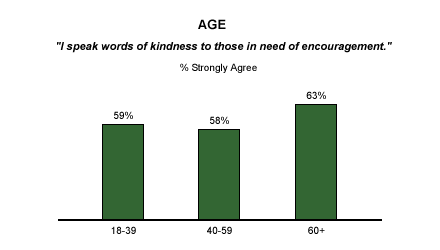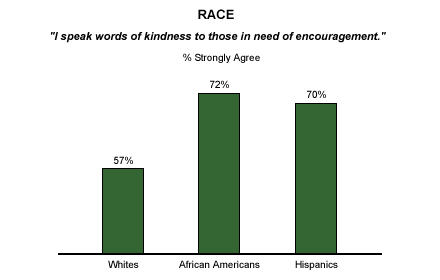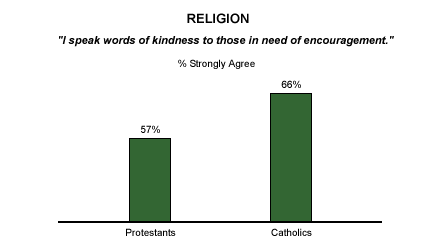This is the 10th in a series of articles examining Gallup's nine items of spiritual commitment.
The nine items that Gallup has discovered best measure the spiritual commitment of individuals in congregations (see "How to Measure Spiritual Commitment" in Related Items) can be divided into those describing attitudes (four items) and those describing behaviors (five items). Last week, I examined the fourth behavioral item, "I will take unpopular stands to defend my faith," (see Related Items). This week's column focuses on the final behavioral item, "I speak words of kindness to those in need of encouragement."
The graph below shows responses to this question on a scale of 1 to 5, with 1 being "strongly disagree" and 5 being "strongly agree."*

People with a high level of spiritual commitment are more compassionate in their attitudes toward others than those who are not. They also go beyond just "feeling sorry" for those in trouble; they act on their compassion by offering encouragement to those experiencing difficulty in their lives.
Once again, when we drill deeper into the data we find that there are some significant differences among population groups. The pattern is similar to the pattern observed for many of the other spiritual commitment items.
Women are more likely to speak words of kindness than are men (66% to 51%, respectively).

Compassion increases slightly with age. Fifty-nine percent of those aged 18 to 39 and 58% of those aged 40 to 59 strongly agreed with this item, while 63% of those aged 60 and older strongly agreed.

Black and Hispanic Americans are more likely to offer comforting words to those in trouble than are white Americans. Fifty-seven percent of whites strongly agreed with this item, but for African Americans and Hispanics, the percentages jump to 72% and 70%, respectively.

Protestants are less likely to speak words of kindness than are Catholics, by a margin of 57% to 66%.

Key Points
While the overall numbers are relatively high on this item (six out of 10 respondents answered "strongly agree"), there are some definite opportunities for improvement. According to the data, it seems that white Protestant males have the most trouble offering words of kindness to those in need of encouragement. This evidence would appear to support the conventional wisdom that men have more difficulty than women do expressing their feelings.
Helping men become more comfortable in situations that require a nurturing presence would be a great benefit to the congregation, and the individuals involved. One of the trends of the past decade has been the explosion in the number of small groups within congregations (see "Americans Find Solace in Small Groups" in Related Items). A strategy for improving the "compassion quotient" among men would be to start small groups designed specifically to meet men's needs and to help them deal with issues unique to them. Participation in small-group settings can help men become more comfortable in expressing concern and compassion they may feel, but aren't used to communicating.
This rounds out our exploration of the nine items that best measure individual spiritual commitment. Spiritual commitment is one of two key elements in the makeup of the congregational spiritual health, and is demonstrated in both attitudes and behaviors. The nine items we explored are indicators of the depth of this these attributes. Faith community leaders need to understand the dynamics of spiritual commitment in order to measure their effectiveness as leaders. Gallup's research shows that the most effective way to increase an individual's personal spiritual commitment is to increase his/her level of engagement within a congregation.
Next week, we begin looking at the 12 items that measure congregational engagement, the other critical component of the spiritual health of faith communities.
The SE25 items are protected by copyright of The Gallup Organization, Princeton, NJ, 2001. All rights reserved.
*Results are based on telephone interviews with 729 adult members of a church, synagogue, or other religious faith community, aged 18 and older, conducted October through November 2001. For results based on this sample, one can say with 95% confidence that the margin of sampling error is ±3.6%.
